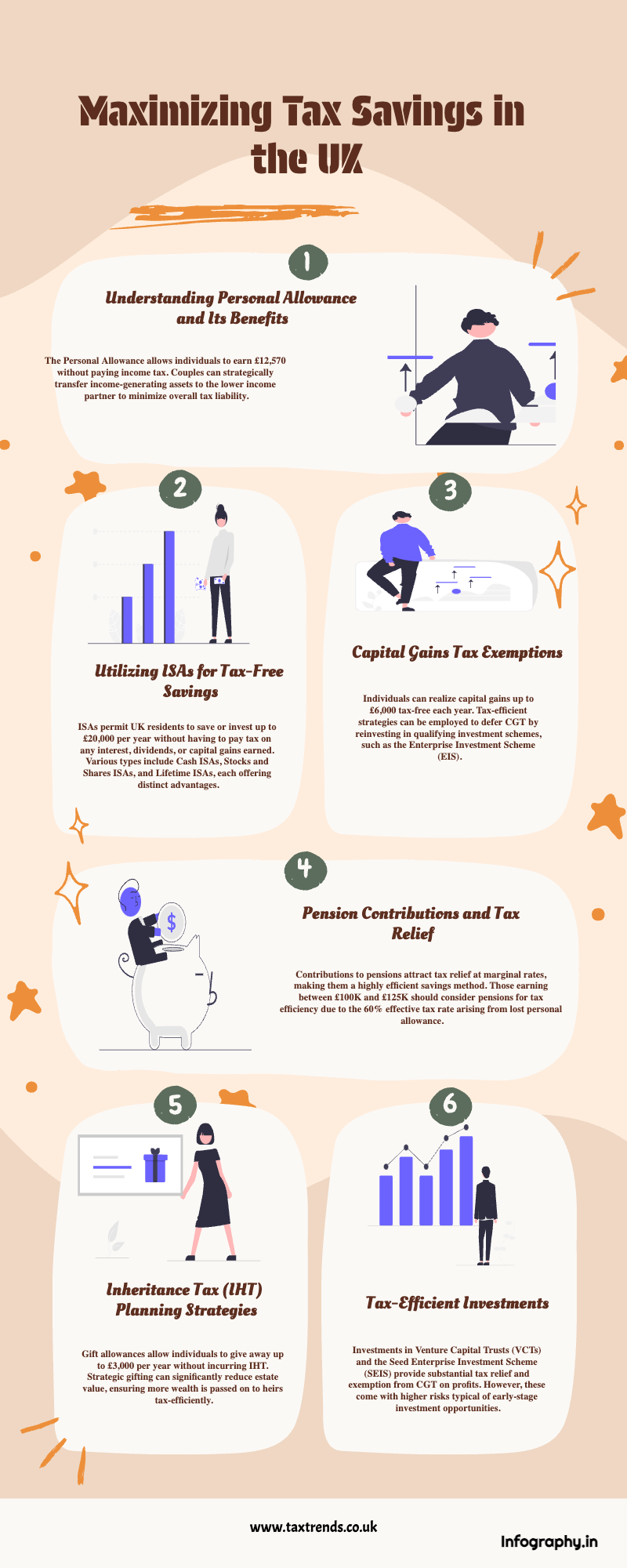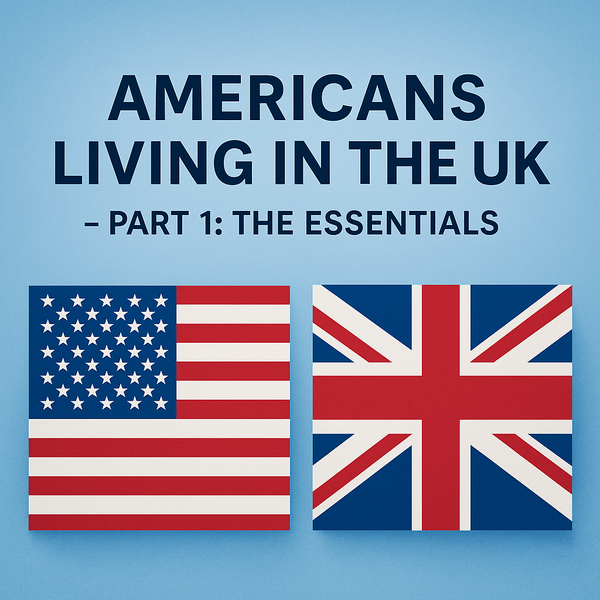The Ultimate Guide to Tax Saving Opportunities in the UK
In the complex landscape of UK taxation, understanding and utilising available tax saving opportunities can significantly impact your financial well-being. Whether you're a salaried employee, self-employed, a business owner, or an investor, the UK tax system offers various legitimate ways to reduce your tax liability and maximise your earnings.
This comprehensive guide explores a wide range of tax saving strategies available to UK residents. From leveraging ISAs and pension contributions to understanding capital gains tax reliefs and inheritance tax planning, we'll delve into both common and lesser-known opportunities that could help you keep more of your hard-earned money.
It's important to note that while tax planning is a crucial aspect of financial management, it should always be done within the bounds of the law and in line with HMRC regulations. The strategies discussed in this article are intended to help you navigate the tax system efficiently, not to evade your tax responsibilities.

As we explore these opportunities, remember that tax laws and allowances can change annually. What works best for you will depend on your individual circumstances, income level, and financial goals. With that in mind, let's dive into the world of UK tax savings and discover how you can make the most of the available opportunities.
1. Income Tax Savings
Personal Allowance
The Personal Allowance is the amount you can earn before you start paying income tax. For the 2023/24 tax year, this is set at £12,570.
Strategy: If you're married or in a civil partnership, and one partner earns less than the Personal Allowance while the other is a higher rate taxpayer, consider transferring income-producing assets (like savings accounts or rental properties) to the lower earner. This can reduce the overall tax paid by the couple.
Salary Sacrifice
Salary sacrifice involves giving up part of your salary in exchange for non-cash benefits from your employer.
Tax Code Check
Your tax code determines how much tax is deducted from your salary. Errors can lead to overpaying.
2. Pension Contributions
Tax Relief on Contributions
Pension contributions receive tax relief at your marginal rate. For people with income between £100K and £125K where the effective marginal tax rate is 60% because of the progressive loss of the personal allowance, contributing to a pension is probably the most tax efficient step they can take.
Carry Forward Unused Allowances
You can use unused pension allowances from up to three previous tax years as long as you had a pension plan open.
3. ISAs (Individual Savings Accounts)
ISAs are tax-efficient savings and investment accounts available to UK residents. They offer a way to save or invest money without paying tax on the interest, dividends, or capital gains.
3.1 Types of ISAs
Cash ISA
- Saves cash tax-free
- Interest rates can be fixed or variable
- Easy access and fixed-term options available
Stocks and Shares ISA
- Invests in stocks, bonds, and funds tax-free
- Potential for higher returns than Cash ISAs, but with higher risk
- Can hold individual shares, funds, investment trusts, and ETFs
Innovative Finance ISA
- Invests in peer-to-peer lending
- Potentially higher returns than Cash ISAs, but with higher risk
- Interest earned is tax-free
Lifetime ISA
- For 18-39 year olds saving for a first home or retirement
- Government adds 25% bonus on contributions up to £4,000 per year
- Can be cash or stocks and shares
Junior ISA
- For children under 18
- Parents or guardians can open and manage the account
- Child takes control at 16, can withdraw at 18
- Can be cash or stocks and shares
3.2 ISA Allowance and Rules
- Total ISA allowance: £20,000 per tax year (2023/24)
- You can split this allowance between different types of ISAs
- Junior ISA allowance: £9,000 per tax year (2023/24), separate from the adult allowance
- You can only open one of each type of ISA per tax year
- You can transfer ISAs between providers without affecting your allowance
3.3 ISA Strategies
- Use your full ISA allowance each year if possible
- Consider stocks and shares for long-term savings to potentially beat inflation
- Use Lifetime ISAs for first-time home purchases or retirement savings
- Start Junior ISAs early to maximise the power of compound growth
- Review and rebalance your ISA portfolio regularly
3.4 Considerations
- Cash ISAs may currently offer lower rates than some high-interest savings accounts
- Stocks and Shares ISAs and Innovative Finance ISAs carry investment risk
- Lifetime ISA withdrawals for other purposes incur a 25% penalty
- Money in a Junior ISA belongs to the child and can't be withdrawn until they're 18
Remember, while ISAs offer excellent tax benefits, it's important to consider your overall financial situation and goals when deciding how to save or invest. Always seek professional advice if you're unsure about the best approach for your circumstances.
4. Capital Gains Tax (CGT) Strategies
Annual Exemption
You can realise capital gains up to £6,000 (2023/24) without paying CGT.
Tax-Efficient Investments
Investments in EIS offer 30% income tax relief and CGT deferral.
5. Inheritance Tax (IHT) Planning
Gift Allowances
You can give away £3,000 per year free of IHT, plus make small gifts of up to £250 per person to any number of people.
Business Property Relief
Certain business assets can qualify for 100% relief from IHT after two years.
For other examples of IHT planning see our article on inheritance tax planning.
6. Tax-Efficient Investments
Tax-efficient investments offer UK residents opportunities to potentially reduce their tax liability while growing their wealth. Here's an in-depth look at some key options:
6.1 Venture Capital Trusts (VCTs)
VCTs are investment companies listed on the London Stock Exchange that invest in small, young, and often high-risk UK businesses.
Benefits:
- 30% income tax relief on investments up to £200,000 per tax year
- Tax-free dividends
- Capital gains tax exemption on profits from VCT shares
Considerations:
- You must hold the shares for at least five years to keep the income tax relief
- VCTs are high-risk investments and you may not get back the amount you invested
- Not all VCTs pay regular dividends
6.2 Enterprise Investment Scheme (EIS)
The EIS encourages investment in smaller, unquoted trading companies.
Benefits:
- 30% income tax relief on investments up to £1 million per tax year (or £2 million if at least £1 million is invested in knowledge-intensive companies)
- Capital gains tax deferral on gains reinvested into EIS-qualifying companies
- Tax-free growth
- Loss relief if the companies fail
Considerations:
- Shares must be held for at least three years to retain the income tax relief
- Investments are in small, often early-stage companies and carry high risk
- Not all EIS investments qualify for all the tax reliefs
6.3 Seed Enterprise Investment Scheme (SEIS)
SEIS is designed to encourage investment in early-stage companies.
Benefits:
- 50% income tax relief on investments up to £100,000 per tax year
- 50% capital gains tax relief on gains reinvested into SEIS-qualifying companies
- Tax-free growth
- Loss relief if the companies fail
Considerations:
- Extremely high-risk due to the early-stage nature of the companies
- Shares must be held for at least three years to retain the tax reliefs
- Limited investment opportunities due to strict qualifying criteria for companies
6.4 Premium Bonds
Premium Bonds are a savings product issued by National Savings and Investments (NS&I), backed by HM Treasury.
Benefits:
- Chance to win tax-free prizes in monthly draws
- Capital is secure and backed by the government
- Easy to cash in
Considerations:
- No guaranteed return – you may win nothing
- The effective "interest rate" depends on luck and the amount invested
- Inflation may erode the real value of your capital over time
6.5 Innovative Finance ISAs (IFISAs)
IFISAs allow you to use some or all of your annual ISA allowance to invest in peer-to-peer lending.
Benefits:
- Tax-free interest on your peer-to-peer loans
- Potential for higher returns compared to Cash ISAs
- Contributes to your overall £20,000 ISA allowance
Considerations:
- Higher risk than Cash ISAs – your capital is at risk and returns are not guaranteed
- May be less liquid than other investments – it might take time to withdraw your money
- The peer-to-peer lending market is relatively new and untested through a full economic cycle
When considering tax-efficient investments, it's crucial to remember that tax treatment depends on individual circumstances and may change in the future. Many of these investments carry significant risks, and it's important to thoroughly understand these risks and how they align with your financial goals and risk tolerance. Always seek advice from a qualified financial advisor before making investment decisions.
7. Property-Related Tax Savings
Rent a Room Scheme
You can earn up to £7,500 per year tax-free by renting out a furnished room in your home.
Principal Private Residence Relief
Your main home is usually exempt from CGT when you sell it. Please check our article on PPR relief for more details.
8. Business Owners and Self-Employed
Claiming Expenses
Ensure you're claiming all allowable business expenses to reduce your taxable profit.
Trading Allowance
The first £1,000 of income from trading or casual services is tax-free.
Incorporation
For some businesses, operating as a limited company can be more tax-efficient than being a sole trader.
Conclusion
Navigating the UK tax system can be complex, but understanding and utilising the various tax saving opportunities available can lead to significant financial benefits. From making the most of your personal allowance and ISA contributions to strategic pension planning and inheritance tax considerations, there are numerous ways to legally and ethically reduce your tax burden.
Key takeaways from this guide include:
- Maximise tax-free savings and investments through ISAs, including Junior ISAs for children.
- Take full advantage of pension tax relief and allowances.
- Understand and utilise capital gains tax exemptions and reliefs.
- Consider tax-efficient investments like VCTs and EIS for potential tax benefits.
- Plan ahead for inheritance tax to protect your estate.
- If you're self-employed or a business owner, ensure you're claiming all eligible expenses and consider whether incorporation could be beneficial.
Remember, while these strategies can be powerful tools in your financial planning toolkit, it's crucial to consider your overall financial situation and long-term goals when making decisions. What works best for one person may not be the optimal solution for another.
Moreover, tax laws and allowances are subject to change, and some tax saving opportunities may have associated risks or restrictions. It's always advisable to stay informed about the latest tax regulations and seek professional advice from a qualified tax advisor or financial planner. They can provide personalised guidance based on your specific circumstances and help you create a comprehensive tax strategy that aligns with your financial objectives.
By staying informed and proactive in your tax planning, you can ensure that you're making the most of the opportunities available to you, potentially saving significant amounts of money in the process. Remember, effective tax planning is not about avoiding taxes, but about not paying more than you legally need to. With the right approach, you can navigate the UK tax system efficiently and keep more of your hard-earned money working for you.



